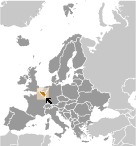World Atlas: Belgium. On this page you can see the map, country flag and many detailed information about the people, history and economy of Belgium.

Here you can find online selected information about the geography, inhabitants, government, economy and history of Belgium. Included are selected statistics, an overview map and the detailed map of Belgium. But let's start with the flag of Belgium here:
Belgium - Overview:
What you should know about Belgium? Let's start with this: Belgium became independent from the Netherlands in 1830; it was occupied by Germany during World Wars I and II. The country prospered in the past half century as a modern, technologically advanced European state and member of NATO and the EU. In recent years, political divisions between the Dutch-speaking Flemish of the north and the French-speaking Walloons of the south have led to constitutional amendments granting these regions formal recognition and autonomy. The capital city of Brussels is home to numerous international organizations including the EU and NATO.
Geography of Belgium
 Where on the globe is Belgium? The location of this country is Western Europe, bordering the North Sea, between France and the Netherlands. Total area of Belgium is 30,528 sq km, of which 30,278 sq km is land. So this is not a large country. How could we describe the terrain of the country? This way: flat coastal plains in northwest, central rolling hills, rugged mountains of Ardennes Forest in southeast. The lowest point of Belgium is North Sea 0 m, the highest point Botrange 694 m. And the climate is temperate; mild winters, cool summers; rainy, humid, cloudy.
Where on the globe is Belgium? The location of this country is Western Europe, bordering the North Sea, between France and the Netherlands. Total area of Belgium is 30,528 sq km, of which 30,278 sq km is land. So this is not a large country. How could we describe the terrain of the country? This way: flat coastal plains in northwest, central rolling hills, rugged mountains of Ardennes Forest in southeast. The lowest point of Belgium is North Sea 0 m, the highest point Botrange 694 m. And the climate is temperate; mild winters, cool summers; rainy, humid, cloudy.
Inhabitants of Belgium
Let's take a look how many people live in Belgium. The number is: 11,491,346 (July 2017 est.). So this is not very populous country. Who lives here? Belgian 75%, Italian 4.1%, Moroccan 3.7%, French 2.4%, Turkish 2%, Dutch 2%, other 12.8% (2011 est.). What are the languages in Belgium? Dutch (official) 60%, French (official) 40%, German (official) less than 1%. And the religions: Roman Catholic 50%, Protestant and other Christian 2.5%, Muslim 5%, Jewish 0.4%, Buddhist 0.3%, atheist 9.2%, none 32.6% (2009 est.). How old are the people in average? 41.4 years. We have to add that this number is the median - so one half of the people is older than this, one half is younger. And what is their life expectancy (at birth)? This: 81.1 years. Where the people live in Belgium? Here: most of the population concentrated in the northern two-thirds of the country; the southeast is more thinly populated; considered to have one of the highest population densities in the world; approximately 97% live in urban areas. The major urban areas of Belgium are: Brussels (capital) 2.045 million; Antwerp 994,000 (2015).
Government and Economy of Belgium
The capital of Belgium is Brussels and the government type federal parliamentary democracy under a constitutional monarchy. Let's take a look at the administrative divisions - 3 regions (French: regions, singular - region; Dutch: gewesten, singular - gewest); Brussels-Capital Region, also known as Brussels Hoofdstedelijk Gewest (Dutch), Region de Bruxelles-Capitale (French long form), Bruxelles-Capitale (French short form); Flemish Region (Flanders), also known as Vlaams Gewest (Dutch long form), Vlaanderen (Dutch short form), Region Flamande (French long form), Flandre (French short form); Walloon Region (Wallonia), also known as Region Wallone (French long form), Wallonie (French short form), Waals Gewest (Dutch long form), Wallonie (Dutch short form). Regarding the economy of Belgium, important industrial products are engineering and metal products, motor vehicle assembly, transportation equipment, scientific instruments, processed food and beverages, chemicals, pharmaceuticals, base metals, textiles, glass, petroleum. Important agricultural products are sugar beets, fresh vegetables, fruits, grain, tobacco; beef, veal, pork, milk. The most important export commodities are chemicals, machinery and equipment, finished diamonds, metals and metal products, foodstuffs and the most important export partners are Germany 16.7%, France 15.4%, Netherlands 11.2%, UK 8.9%, US 5.8%, Italy 5.2% (2016). The most important import commodities are raw materials, machinery and equipment, chemicals, raw diamonds, pharmaceuticals, foodstuffs, transportation equipment, oil products and the most important import partners are Netherlands 16.1%, Germany 13.6%, France 9.5%, US 8.1%, UK 4.8%, Ireland 4.5%, China 4.3% (2016). How rich is Belgium and how rich are people in this country? The most important number here is GDP per capita (PPP): $46,300 (2017 est.). This means the people are rich on average here. Let's add that this means Gross Domestic Product per person, which is recalculated with respect to the relative cost of local goods and services. And one more important number - population below poverty line: 15.1% (2013 est.).